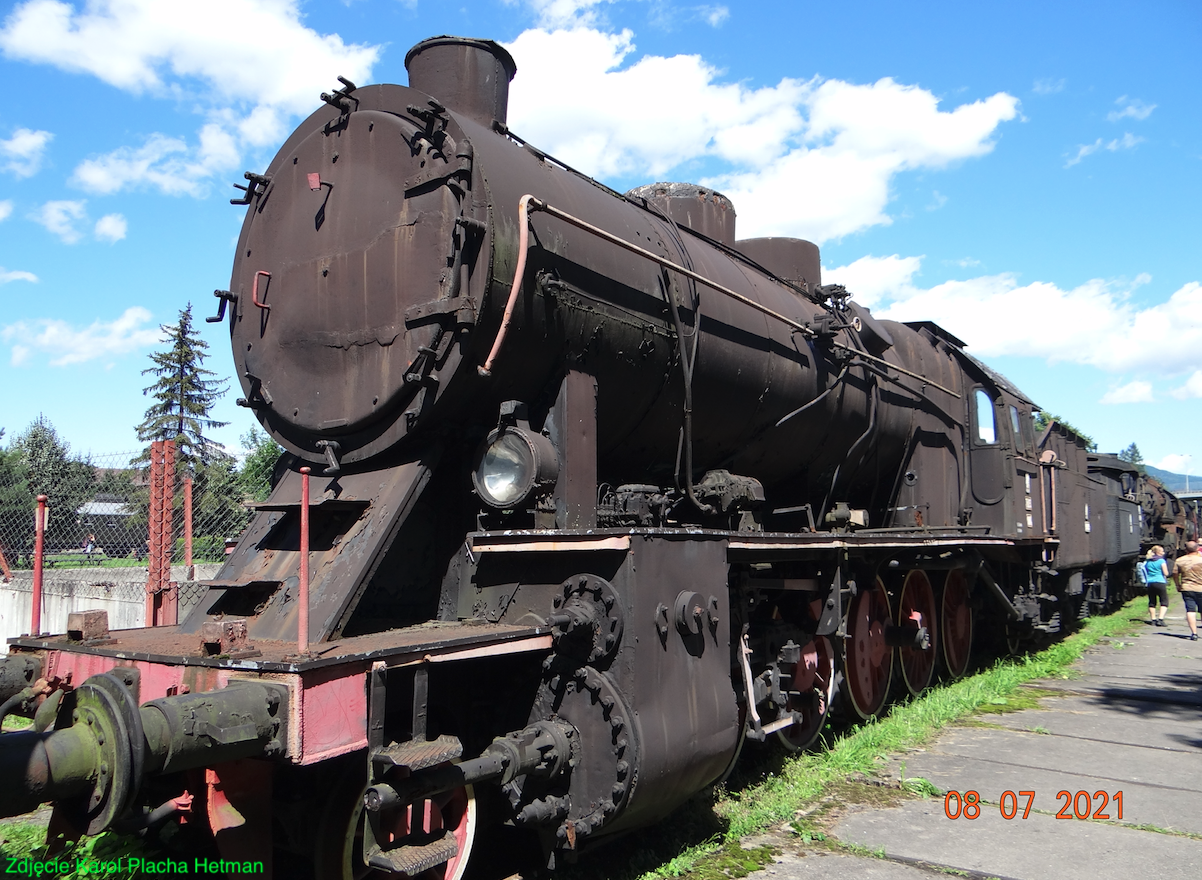Gdańsk 2021-01-25
Gdańsk Rębiechowo – railway and railway line No. 201.
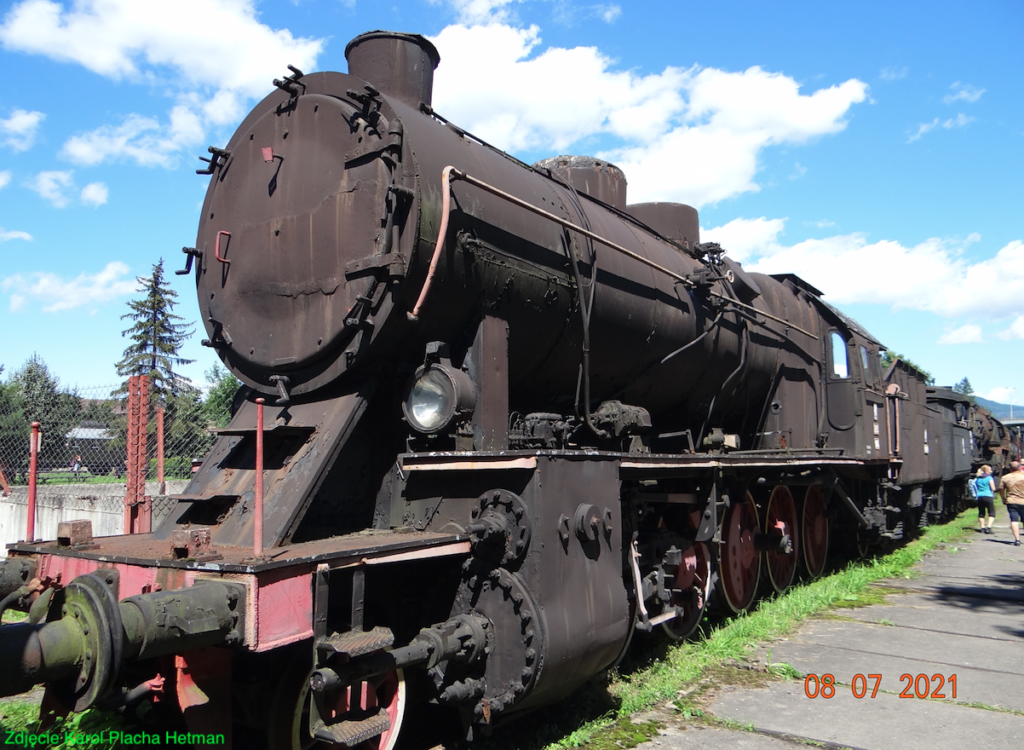
Photo description: The Ty23 series steam locomotive was a Polish heavy steam locomotive, which was developed by Polish engineers and produced in the period 1923 – 1934. Ty23 means a freight locomotive with an axle arrangement “y”, which was approved in 1923. Axle arrangement 1’E, i.e. 1-5-0 (oOOOOO), and the Polish designation is the lowercase letter “y”. Locomotives of this type worked during the Second Polish Republic on the railway route No. 201, transporting hard coal from Polish Silesia to the seaport in Gdynia.
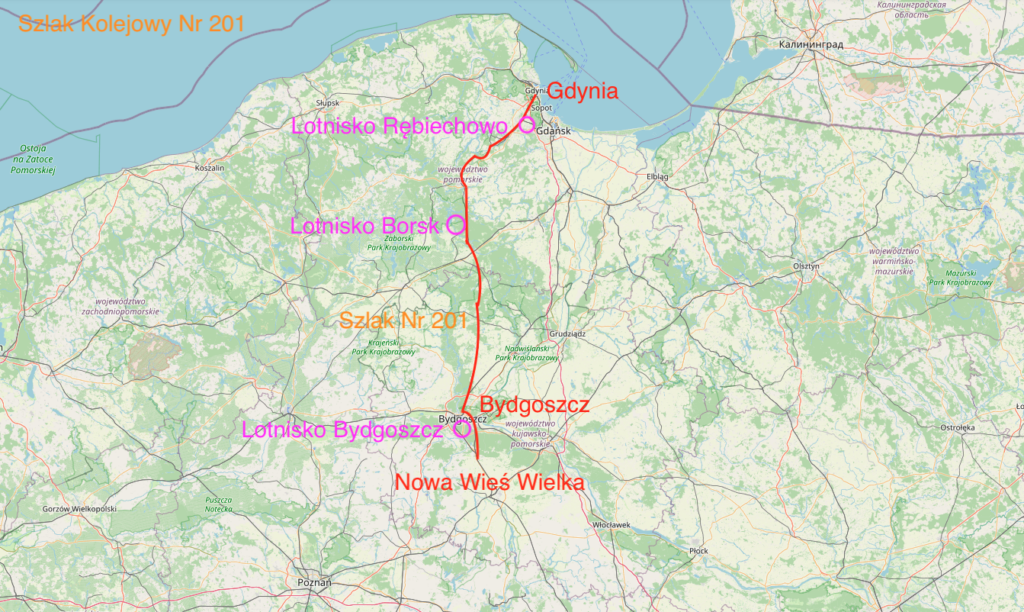
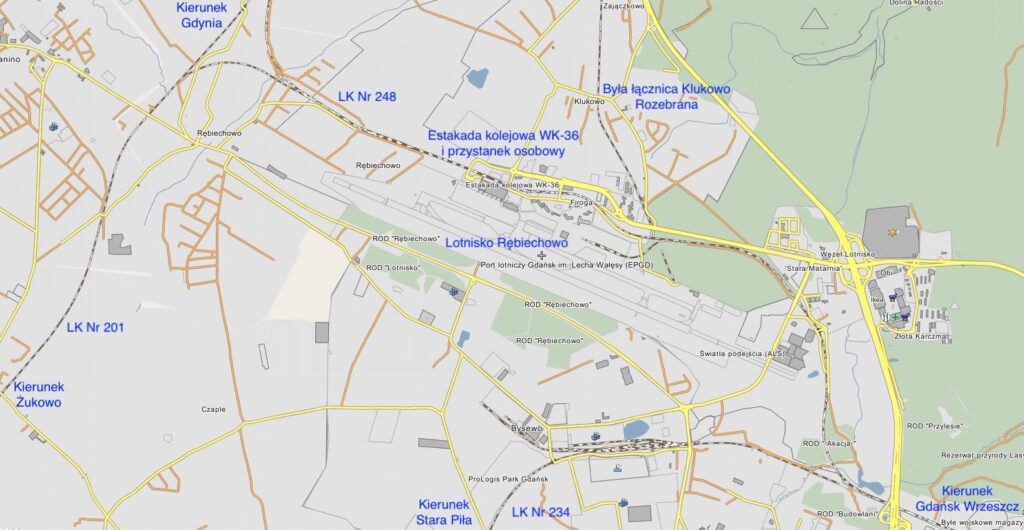
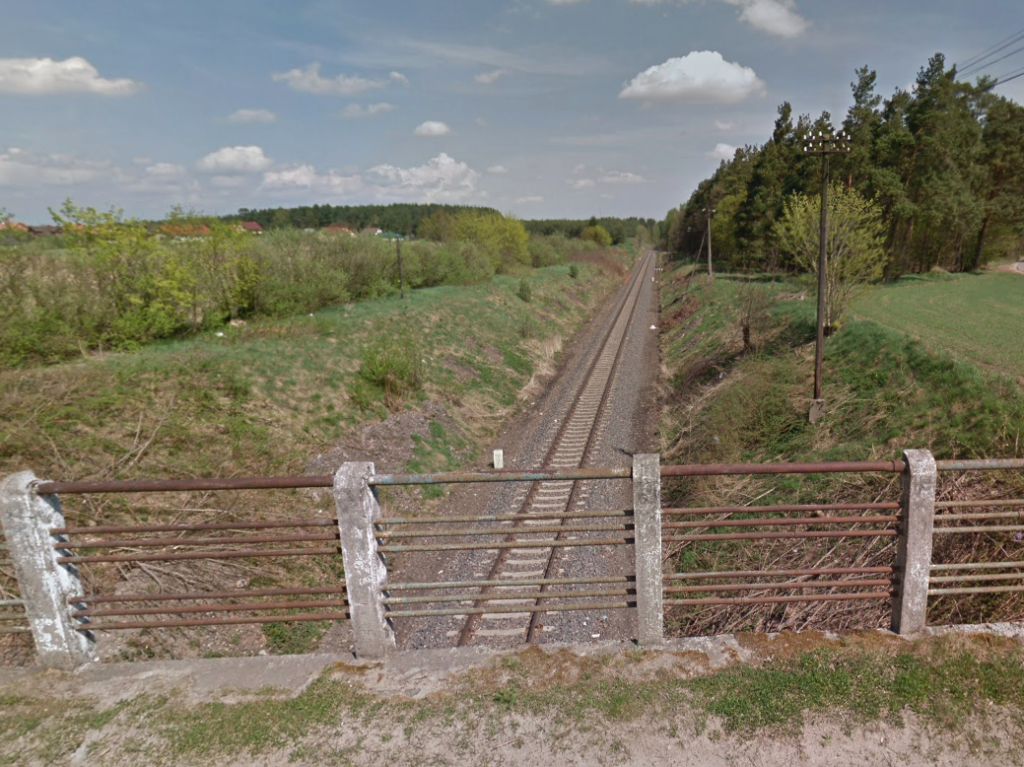
By train to the Gdańsk-Rębiechowo Airport.
The 90s of the 20th century and the first decade of the 21st century were the period of liquidation of railways in Poland. However, the experience of other countries has shown that railways are a good means of transport. In 2010, the first plans for the reconstruction of the railway network in the Tri-City area were made. The project was called the Metropolitan Railway. The Ministry of Regional Development entered the investment on the list of projects financed under the Infrastructure and Environment Operational Program. The investment was divided into several stages, as its cost was estimated at PLN 650 million. Half of this amount came from EU subsidies (European Union), and the rest from the provincial authorities, Gdańsk, Gdynia and the PKP company. The Metropolitan Railway was a big step in the development of the Tri-City Agglomeration. The new line starts at the height of the SKM Gdańsk Zaspa stop. Along the old railway embankment, along which the Gdańsk – Gdańsk Kokoszki line once ran, and reaches the vicinity of the airport terminal. Several stops have been built on this section: Gdańsk Strzyża, Gdańsk Niedźwiednik, Gdańsk Brętowo, Gdańsk Jasień, Gdańsk Kiełpienik, Gdańsk Maternia, Gdańsk Port Lotniczy and Gdańsk Rębiechowo.
The railway line is double-track, not electrified. There are plans to electrify the line by 2025. Many sections of the track run along the former railway embankment. In the first years of operation, there were problems with landslides from the embankments after heavy rains. At the Rębiechowo Airport itself, it was decided to build a viaduct, the total length of which is 900 m. The viaduct allowed the preservation of the layout of car roads and parking lots at the airport. The line has been electrified.
The Gdańsk Airport stop was not named Gdańsk Airport, because there was such a stop at the Wrzeszcz Airport. The stop has two platforms, which are connected to Terminal No. 2 by a covered, glass footbridge.
The metropolitan railway line continues. It runs in a north-westerly direction, and then branches left and right to the Gdynia-Żukowo railway line (north-south direction). This is precisely the railway line No. 201 Gdynia Port – Nowa Wieś Wielka. Railway line No. 201 is part of the Coal Trunk Line, one of the main investments in the Second Polish Republic and was a line of national importance. Due to the Germanic invasion of Poland, the line lost its importance and was a local line. Currently (2020), the metropolitan line has opened the Tri-City to Kartuzy and Kościerzyna. The railway line makes it easier for passengers to reach the Airport and Gdańsk. About 46 million euros were spent on the modernization of the Kościerzyna route in the Regional Operational Program, and the modernization was completed in 2015. The journey from Kartuzy to the Airport takes 30 minutes.
The metropolitan railway line was officially opened on September 1, 2015. The railway carries 1000-2000 passengers per day. The line is served by SKM and PolRegio trains. These are diesel, two-, three- or four-carriage sets. Tickets can be purchased from ticket machines at train stops or from the train manager (conductor). The SKM and PolRegio carrier tariff applies.
Railway history in the vicinity of the airports: Rębiechowo (Gdańsk), Borsk (Former military airport), Szwedowo (Bydgoszcz).
On the western side of the Rębiechowo airport runs the No. 201 railway line, of national importance to Poland. In 1918, Poland regained independence, and the reconstruction and development of the devastated country began. One of the priorities was the development of railways, which were the main pillar of transport. In 1920, the Polish government established the main transport routes. One of the main routes was the one leading from Silesia to the Coast. Since cooperation with the Germans was not going well, it was decided to run the planned routes in such a way as to bypass the Germanic territories, as well as the area of the Free City of Gdańsk, whose authorities manifested open hostility towards Poland. The Germans often referred to Poland as a “seasonal state”. This is still the case. This is one of the reasons why Poland built the “Port Gdynia”.
Railway line No. 201 – History.
Detailed plans of railway routes were created in the period 1926-1928. Among them, Railway line No. 201, generally referred to as Bydgoszcz-Gdynia. The new main line was to run as close to a straight line as possible. The route, due to modest funds, was to be single-track, with the prospect of building a second track. This forced the construction of passing places at equal intervals regardless of existing towns. This is how stations were created among forests. The line became one of the most picturesque in Poland. It lies in the Kuyavian-Pomeranian and Pomeranian Voivodeships. Geographically, it runs through the Pomeranian Lake District, the Kashubian Lake District and the Gdańsk Coast.
Already in 1925, a government regulation was ready, under which it was possible to expropriate the owners of real estate needed to build the railway. The railway line itself was built by a state-owned company, but the bridges and other infrastructure were built by private companies, after winning tenders. Route No. 201 was put into service in stages. The first stage, around Bydgoszcz, was put into service on May 15, 1928. It runs some distance from the Szwedowo airport. The second stage was the Czersk-Bąk-Kościerzyna section, which shortened the Tczew-Kościerzyna route, without the need to travel to Chojnice. The Czersk-Bąk section runs along a strange route, because the Poles used the Karsin-Bąk railway embankment, the Chojnice-Gdańsk line not built by the Germans, which would have been an extension of railway line No. 210 (Berlin-Królewiec). In 1930, the French joined the construction program for line No. 201 and a company was established: the French-Polish Railway Company. The establishment of the company accelerated the construction.
On November 9, 1930, route No. 201 was already passable along its entire length. From Gdynia Główna station, line No. 201 was transformed into the “Port Gdynia” railway siding. Until 1933, station buildings, water towers and coaling facilities were built along route No. 201. In connection with the demands of residents, additional stations were built along the route, for example Babi Dół and Żukowo Wschodnie.
For 30 years, line No. 201 was mainly used by freight trains and express trains from Gdynia to Warsaw, Krakow, Lviv and Silesia. Most regular passenger trains ran from Tczew to Gdańsk.
During World War II, route No. 201 was significantly damaged. The occupier mainly used the Tczew-Pruszcz Gdański-Gdańsk route.
After World War II, only in 1949, was traffic restored on line No. 201. Route No. 201 was important because the Tczew-Gdańsk section was very congested with train traffic. Route No. 201 contributed to the development of local industry and the cities of Kartuzy, Kościerzyna, Szlachta, Wierzchucin. From 1960, passenger traffic developed rapidly. Especially on the Kościerzyna-Gdynia section. There were plans to build a second track, which were not carried out. In 1969, the Bydgoszcz-Tczew route (No. 727) and Tczew-Trójmiasto (No. 9) were electrified. Therefore, transit trains with electric locomotives were directed to this route. On route No. 201, as recently as the 1970s, trains were mainly pulled by steam locomotives. In 1978, the Northern Directorate of PKP still had 13 operational steam locomotives. The problem was that Poland had its own hard coal, and oil for diesel locomotives had to be imported.
In the 1980s, line No. 201 was constantly maintained in full working order, but without major new investments. On the route, you can still see railway traffic control devices from the 40s. The construction of a second track or electrification was abandoned. The trains were operated by diesel locomotives.
After 1989, freight transport decreased significantly, especially hard coal. Freight transport was carried out on the routes from Chojnice and Bydgoszcz to Gdynia. In 1990, the last scheduled express train from Gdynia to Wrocław passed through Kościerzyna. Local passenger traffic gradually decreased. More and more people used buses and their own cars.
In 1991, the locomotive shed in Kościerzyna was closed. This was the definitive end of steam locomotives, in route and shunting traffic. From then on, steam locomotives are only used as heritage trains and tourist attractions.
In 1992, the first SA 101 series railbuses appeared on the Kościerzyna–Gdynia route, and in 1994, the two-unit SA 102. In the 1990s, passenger traffic was also served by double-decker cars, which were pulled by SM-42 diesel locomotives, in a version with the possibility of heating passenger cars. A typical passenger train consisted of an SM-42 locomotive, a double-decker car (2nd class) and a passenger car (1st class).
In 2000, the Nowa Wieś Wielka – Bydgoszcz Wschód section was closed to passenger (passenger) traffic, but in the summer the Katowice – Słupsk holiday train still ran here.
In 2006, the Bory Tucholskie holiday express train from Warsaw Wschodnia to Kołobrzeg was launched. This train passed through route No. 201, on the Maksymilianowo – Wierzchucin section, without stopping at any station. This connection was the longest route operated by PKP InterCity using diesel traction. Express trains used this route until 2016. The Bydgoszcz-Wierzchucin-Tuchola-Chojnice route is still operated by passenger trains. Generally, route No. 201 was still used by passenger trains.
In 2010, Newag Nowy Sącz transferred two two-unit diesel multiple units to the Pomeranian Voivodeship, the SA 137 (NEWAG 220 M) two-unit trains and the SA 138 (NEWAG 221 M) three-unit trains. At that time, freight trains were mainly operated by SM-44 and SM-42 locomotives.
In 2011, the revitalization of route No. 201 on the Kościerzyna-Gdynia section began, which was completed in 2015. The modernization included replacing the surface, building new platforms and replacing turnouts. As a result of the modernization, the speed was increased to 120 km/h; previously, the speed ranged from 60 km/h to 100 km/h. In subsequent years, the Maksymilianowo-Wierzchucin section was modernized.
In the period 2011-2018, passenger traffic on line No. 201 was minimal. The revival of passenger traffic took place in 2018, when the district governments joined the cooperation. Two-unit SA 133 (PESA 218 M) and three-unit SA 134 (PESA 218 M) trains were purchased. First as a pilot, for summer season, and then year-round. Regular regional train traffic is provided by Arriva RP, almost along the entire route, and by PKP Szybka Kolej Miejska in the Tri-City, up to Kościerzyna. The carrier operates three-unit SA 136 (PESA 219 M) trains. Many journeys are performed by two trains connected together. Long-distance passenger trains on route No. 201 appear occasionally.
Railway line No. 201 – Basic data.
Railway line No. 201 (historically 416, 431, 440) is 212 km long. The line is electrified only on a small section, in the Bydgoszcz area (Nowa Wieś Wielka – Maksymilianowo) and in Gdynia (Gdynia Główna – Gdynia Port). Line No. 201 provides the highest speed of 120 km/h. The average speed is 100 km/h. The line is being systematically modernized. It has a safety system with SHP electromagnets along its entire length. Signal crossing shields are being introduced for road railway crossings. You can still find shape semaphores, which are systematically replaced with light semaphores. Railway stations and stops are being modernized.
Railway line no. 201 runs through the following stations: Nowa Wieś Wielka, Emilianowo, Żółwin, Bydgoszcz Wschód, Bydgoszcz Bielawy, Bydgoszcz Leśna, Rynkowo, Maksymilianowo, Stronno, Wudzyn, Serock, Lubania-Lipiny, Świekatowo, Lipienica, Błądzim, Wierzchucin, Zielonka Pomorska, Małe Gacno, Zarośla, Rosochatka, Lipowa Tuchola, Stary Kierz, Łęg Południowy, Szałamaje, Wojtal, Bąk, Wdzydza, Olpuch, Olpuch Wdzydze, Podles, Kościerzyna, Skorzewo, Gołubie Kaszubskie, Krzeszna, Wieżyca, Sławki, Somonino, Kielpino Kartuskie, Babi Dół, Glincz, Borkowo, Żukowo, Żukowo Wschodnie, Pępowo Kartuskie, Rębiechowo, Gdańsk Osowa, Osowa, Wielki Kack, Gdynia Karwiny, Gdynia Stadium, Gdynia Główna.
There were two locomotive sheds on the No. 201 railway line. The first one was Kapuścisko Tranzytowe, and currently Bydgoszcz Wschód Towarowa. The second one was Kościerzyna, built in 1885 and expanded in 1928. In 1992, the locomotive shed was transformed into the Railway Museum in Kościerzyna. At some stations on the No. 201 route, apartments for railway workers were also built. First of all, in the station buildings, but also in separate apartment blocks.
The No. 201 route was designed in such a way that it is possible to add a second track. On long sections, the glue embankment or ravine is wide enough to accommodate a second track. Many bridges and viaducts provided for the addition of a second track.
Railway line no. 201 – Description.
The No. 201 railway line starts in Nowa Wieś Wielka, which lies south of Bydgoszcz. Here it branches off the Inowrocław-Bydgoszcz route to the right, to bypass Bydgoszcz from its eastern side. The line is double-track, electrified. The route runs through the forest, where the Emilianowo freight station was built (10 km). Emilianowo station was launched in 1930, and serves as a logistics and transshipment station. The platforms that were here were removed, because the station does not serve passenger traffic. Then the route runs under the DK 10 viaduct (Szosa Obwodowa). Numerous sidings to industrial plants branch off from the route. Then the route crosses the Brda River and reaches the eastern suburbs of Bydgoszcz. Here the route runs over railway line No. 18 (Kutno-Toruń-Bydgoszcz-Piła) and after a sharp turn to the west runs parallel to route No. 18. Both lines intertwine. The route passes: Bydgoszcz Wschód Towarowy, Bydgoszcz Bielawy, Bydgoszcz Leśna (24 km). The line, being on the northern side of Bydgoszcz, route No. 18 turns south, and route No. 201 turns north. At the height of Rynkowo station, route No. 201 connects with route No. 131 (Coal Main Line). The tracks of both routes intertwine. The routes reach the Maksymilianowo station.
Behind the Maksymilianowo station (33 km), at the height of the new viaduct of the S5 expressway, the two routes split. Route No. 131 runs towards Tczew, and route No. 201 turns a little to the left, directly north. Railway line No. 201 becomes single-track and non-electrified. It runs along long straight sections, mainly having small villages and farmlands nearby.
The route reaches the Stronno station (42 km), or rather, currently a stop. Stronno was a station and served as a passing place, and steam locomotives replenished water and coal here. In the 1990s, the side tracks were dismantled and only the main track remained. The station buildings remained, which are inhabited. Then route No. 201 crosses DK 56, which connects Dobrych with Koronowo, with a length of only 20 km.
Further on is Wudzyn (46 km), a railway stop. Next is the Serock railway station (50 km). It currently serves as a passing station. Previously, it was a station with full facilities. The next one is Lubania-Lipiny, and it is a passenger stop. Świekatowo (57 km) is a passenger stop. Formerly, Świekatowo was a station, but the passing and additional tracks were dismantled. Two signal boxes remain. It is worth knowing that there was also a second station in Świekatowo, Świekatowo Wschodnie. Świekatowo Wschodnie is a disused railway station on the former route of the Świecie nad Wisłą – Złotów railway line, in the east-west direction. These lines crossed, but it was not possible to redirect trains from one route to the other. Route No. 201 runs under the viaduct, and the dismantled line on the viaduct. At the Świekatowo Wschodnie station, there is a station building, currently adapted for residential premises. There is a historic Intze-type water tower from the beginning of the 20th century. There are two platforms lined with paving slabs, a transshipment area and a railway gauge.
The next Lipienica (60 km) is a railway stop. From Lipienica, the trail increasingly runs through forests. Błądzim is currently a railway stop. Błądzim was a railway station with full facilities. Later, it was degraded to a passing place, and in 2001, the side tracks and switches were removed. The station building has been preserved in good condition. Further on, trail No. 201 crosses provincial road No. 240.
Wierzchucin (71 km) is a railway station where trail No. 201 intersects with trail No. 208 Działdowo-Chojnice, from east to west. Wierzchucin is a railway station with full facilities. The station has 8 tracks. There is a station building, signal boxes and two platforms. The water tower has been preserved.
Zielonka Pomorska (75 km) is a railway stop. There was never a railway station here. Małe Gacno used to be a passing loop, there were two signal boxes that were dismantled in the 1990s. Zarośla is a train stop. Zarośla used to be a station with incomplete facilities. Then it was changed to a passing loop. Rosochatka is a train stop. Lipowa Tucholska (94 km) is a junction railway station in Lipowa near the town of Szlachta. The junction consists of three railway stations: Lipowa Tuchola, Szlachta, Szlachta Zachodnia. The junction connects: line No. 201, line No. 743 Lipowa Tucholska – Szlachta, line No. 744 Lipowa Tucholska – Szlachta Zachód. The junction allows you to travel to Czersk (west), to Dąbrowa (Line No. 131, east), to Smętowo (Line No. 131, east). There is a water tower at the Lipowa Tuchola station. Route No. 201 completely bypasses the town of Szlachta and always runs straight north.
Stary Kierz is a railway stop that was not always open and not all local passenger trains stopped here.
Łąg Południowy (103 km) is a passenger stop. The town of Łąg has two railway stations: Łąg Południowy on route No. 201 and on the Czersk-Starogard Gdański route No. 203 (double-track, non-electrified line), called Łąg station. Railway routes No. 201 and No. 203 only cross. Route No. 201 runs on a viaduct, and No. 203 under a viaduct. Both routes are connected by the Czersk-Karsin-Bąk railway line. In the town of Łąg, route No. 201 runs on a viaduct above the DK 22 road.
Next: Szałamaje and Wojtal are passenger stops.
Bąk is 117 km. Plans to build a railway route through Bąk were made during the German Empire to connect Berlin with Gdańsk and Królewiec. It was to be an extension of railway line No. 210 from Chojnice. Before the outbreak of the Great World War, only part of the earthworks had been completed, including on the Krasin-Bąk section. After Poland regained independence, part of the earthworks were used. Work began in 1925 and in 1928, route No. 215 Czersk-Krasin-Bąk was launched. Krasin was a passing place. Route No. 215 facilitated the construction of route No. 201. A railway siding was built from the Bąk railway station to the Borsk airport. The siding was built around 1955. The siding was liquidated before 2012.
Further on route No. 201 are the following stations: Wdzydze, Olpuch, Olpuch Wdzydze and Podleś. From the Olpuch Wdzydze station the terrain becomes more varied. There are lakes, hills and valleys, which caused difficulties in running the No. 201 railway line. Kościerzyna is 137 km of route No. 201. The first railway line reached Kościerzyna in 1885. It was the Pszczółki–Kościerzyna line (No. 233), which allowed access to the Tczew-Gdańsk line. Line No. 233 was dismantled in 1933. In 1885, a locomotive shed was built in Kościerzyna. In 1990, a line to Kartuzy was built, which was partially used by the No. 201 line under construction, as well as a line to Lipuszy, which was extended to Chojnice in 1901. Kościerzyna became a railway junction. As early as 1905, the Kartuzy – Stara Piła – Gdańsk Kiełpinek – Gdańsk Główny railway line was built. In 1928, the Poles expanded the locomotive shed in Kościerzyna, with route No. 201 in mind. In 1992, the locomotive shed was closed and a railway open-air museum was opened. Currently, Kościerzyna is a large railway junction, where lines No. 201 and No. 211 to Chojnice intersect. The station has a dozen or so tracks and two platforms. By 2018, the section of route No. 201 Kościerzyna-Gdynia Główna had been renovated. The track and switches were replaced. Light semaphores were installed. New platforms were built, adapted to serve disabled people, families with children in strollers and cyclists. The route is technically difficult, but safe. The route provides a maximum speed of 100 km/h.
Skorzewo is currently a stop. Skorzewo station was built in 1938. Then it served as a passing loop.
Gołubie Kaszubskie is a station with passing loop tracks and a siding. It is worth knowing that in 1901, the Kościerzyna – Gołubie Kaszubskie track was built, through Nowa Wieś Pomorska and Sikorzyn, which was used until 1930.
Further on there are three railway stops: Krzeszna, Wieżyca, Sławki. Wieżyca was previously a station. There is still a side track, unused. In its place is a platform. The village of Wierzyca is famous for the highest elevation in the Kashubian Lake District, with the same name 329 m above sea level. In 1999, Wieżyca became only a passenger stop.
Somonino (163 km) is a station where the trail to Kartuzy No. 214 branches off from trail No. 201. The next two stops are: Kiełpino Kartuskie and Babi Dół.
Glincz (175 km) is a town where the tracks of trail No. 201 and No. 229 Kartuzy-Pruszcz Gdański intertwine.
Bukowo is a railway stop. Here the track runs along a viaduct over the DW 211 road. Żukowo is a railway stop opened in 2014. Żukowo Wschodnie (179 km) is a railway station opened in 1932. There is a passing track at the station. Pępowo Kartuskie is a railway stop.
Rębiechowo (184 km) is a railway stop. Behind the stop there is a track branching off towards the Rębiechowo airport and to Gdańsk, and a little further on there are two tracks, also from the airport and Gdańsk. From this point, route No. 201 is double-track. The section of route No. 201 to Gdynia underwent a general renovation as part of the modification of the entire railway network in the Tri-City agglomeration.
Further on is the large Gdańsk Osowa station (189 km), which has six tracks and two large platforms. In addition to route No. 201, there is route 235 Gdańsk Osowa – Kokoszki and route No. 248 Gdańsk Osowa – Gdańsk Wrzeszcz. This is already a highly urbanized area.
Then the route is technically difficult due to overcoming a large difference in the height of the terrain. The route runs under the viaduct of the S6 expressway. Then there is the Wielki Kack railway station, which is mainly important as a freight station.
Gdynia Karwiny (196 km) is a railway stop located on a sharp curve. We have three tracks here, but some are braided with others, i.e. a track weave. This technical solution was used for trains with oversized goods. In 2018, the stop was put into operation after renovation.
Then there is a serpentine, which is designed to reduce the steepness of the slope. The tracks are almost always curved. Then there is the Gdynia Stadion station (202 km), which is a through station without any switches or side tracks. As part of the modernization, the station was moved closer to the sports stadium. Then the No. 201 route splits so that the left track from the east goes to the Gdańsk Główny – Gdynia Główna railway route. Before the Gdynia Główna station (205 km), both routes intertwine.
Written by Karol Placha Hetman
